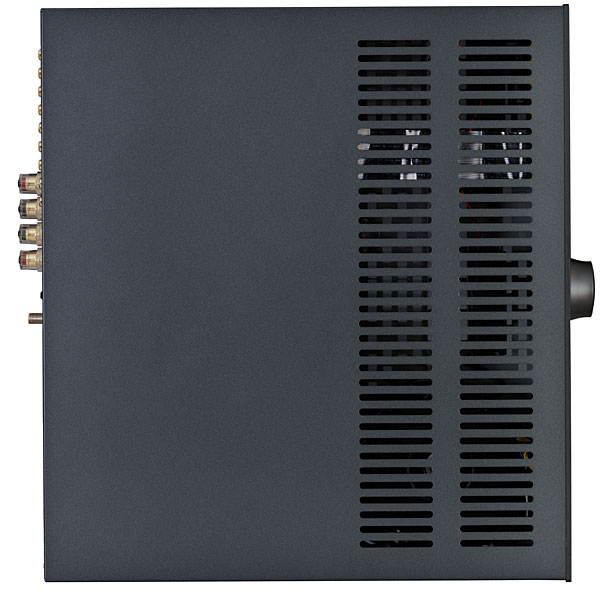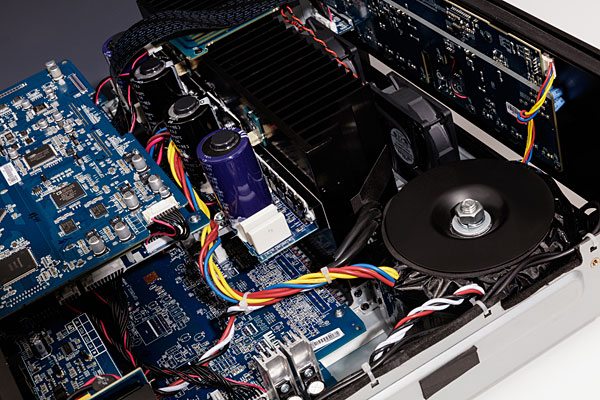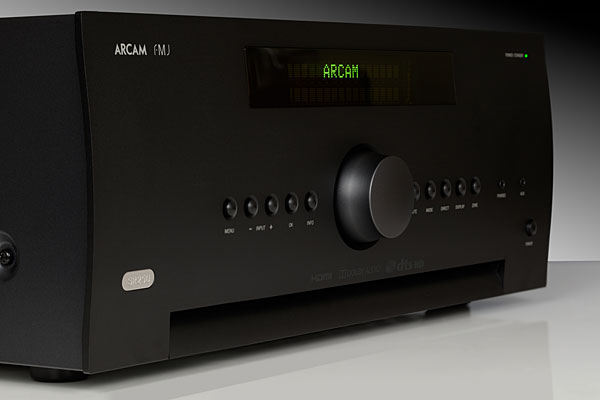| Columns Retired Columns & Blogs |
"Stereophile seldom reviews A/V receivers."
Is that because they aren't esoteric enough or not expensive enough for the audiophile cache?
Arcam's remote control is illuminated and capable, and was comfortable to use. However, in their zeal to ensure that it can control an entire A/V system's worth of Arcam products, Arcam has made it frustrating to use when the SR250 is the only device it controls. It seems that while pressing an input-selection button does select that source—say, a CD player—it also changes the function of all its other buttons to control the operation of that source. However, if you want to continue using it to control only the SR250, you must push Amp to restore the other buttons to their original functions. In the long run, I guess I'd get used to hitting Amp every time I chose another input, but it led to much annoyance and fitful button-pushing during the review period. On the other hand, Arcam's app, Music Life, was a breeze for control as well as for streaming files from my NAS.

Before invoking Dirac Live room correction, I used the system for about two weeks, partly to dilute my internal reference—the system's multichannel, room-equalized sound—and partly just to enjoy it. The FMJ SR250 worked well in this system. The Monitor Silver 8s sounded as good as ever, with wide, deep soundstages; and, without bass management or subs, the bass was good, solid, and balanced. The central imaging was convincing and stable enough to make me suspect I'd forgotten to disconnect my center-channel speaker. (I hadn't.) Voices, low or high, sounded natural, with good presence. In short, this was excellent stereo sound. But my reasons for reviewing this 2.1-channel AVR were its bass management and room-EQ features.
Arcam's bass management is conventional, requiring the user to choose a crossover frequency and set relative levels for the main speakers and subs. The SR250 has two sub outputs; I used both. The results were okay, and as much as one can hope for from a two-channel system: aside from a bit more boot in the bass, not an improvement over running just the stereo pair of speakers. Also, because I no longer believe in using subwoofers without EQ—because subs cover the part of the audioband most influenced by room acoustics—I wasted little time in moving on to setting up Dirac Live.
I've had a good bit of experience with Dirac Live, and figured that setting it up in the FMJ SR250 would be pretty much the same as it was with the full Dirac Suite on my servers. I downloaded the Dirac app from the Arcam website and installed it in my Windows laptop. Then I plugged in Arcam's calibration microphone (supplied) and booted up the app. It's an analog mike with an analog/USB sound dongle, and my laptop only sporadically recognized the mike and dongle. The interruptions required me to restart the calibration several times, until the dongle simply fell apart. Then, as advised by Arcam's Andy Moore, I used the same miniDSP UMIK-1 microphone that I usually use for Dirac.

After that, it was smooth sailing. The onscreen instructions are identical to other Dirac implementations, except that they're limited to the left and right speakers and two subs. The app doesn't require the user to choose sampling rates for the correction filters, because Arcam runs Dirac Live at up to 24-bit/96kHz, downsampling 24/192 for the S/PDIF inputs to 24/96 as needed. (The USB and Ethernet ports are limited to 44.1 and 48kHz data and sample-rate-converted to 48 or 96kHz as selected with the set-up menu.) Dirac Live supports the options to shape the target curves for all channels and to restrict correction to the desired bands. Multiple measurement sets and calibrations can be stored on a PC or Mac for later recall and reinstallation; the SR250 itself can store only one set at a time.
The SR250's remote control does have a very useful button for turning Dirac Live on or off on the fly. When I used it to compare the sound with and without EQ, I discovered that the EQ output was about 9dB higher in level than the non-EQ output, which made comparisons impossible. It turns out that Dirac Live boosted both L and R levels in addition to setting the speaker distances and balancing the outputs of the speakers with those of the subs, but made no global changes in channel level or delay. To level the playing field in order to fairly assess what Dirac Live was doing, I had to go back to the SR250's original, non-EQ'd setup and manually adjust those levels and distances to match the ones Dirac Live had chosen.

Having made those adjustments, and using the remote's handy-dandy button, it was then easy to hear that the first of my several Dirac Live calibrations was the best, objectively and subjectively. The most salient improvements wrought by the EQ were the tightness and definition of the bass from the lowest end of the subs' outputs, through the crossover range, and up to about 200Hz, as well as wider soundstages. These are among the benefits one expects from good room correction, and fully justifies its use in two-channel systems. By applying Dirac Live, the sound of the SR250 was made even more satisfying and communicative..
Conclusions
The Arcam FMJ SR250 is a modern, highly evolved integrated amplifier with well-balanced sound and the ability to drive and control any speakers it's likely to be paired with. It performed well via its S/PDIF digital and analog inputs and from streaming sources. If you choose to view it as a receiver because it has FM/DAB tuners and HDMI inputs, that's okay, too. However, its full implementation of Dirac Live room EQ makes it unique for a 2.1-channel product. Good as the FMJ SR250's conventional stereo sound is, this feature sets it apart from seemingly comparable devices Think of it as an integrated amplifier with benefits.

"Stereophile seldom reviews A/V receivers."
Is that because they aren't esoteric enough or not expensive enough for the audiophile cache?

I imagine that's much of it, yeah. Also, maybe they're too convenient, there are more than a handful of boutique dealers/sources for them, and they mean less opportunity for outboard DACs, uber-expensive interconnects. Oh, and you don't get to explain them to your friends and guests.

We should see how A/V receivers stack up. Why aren't more A/V receivers being reviewed from time to time? Does one have to cost more than one (two or three in cheaper communities) times of total monthly expenses of many people for it to be tested here?
I know there are time and budget constraints. I know you can't test everything. But then, what's the impediment? Many readers of this publication own A/V receivers; perhaps that's all they will ever own. Might it not be "revelatory" (an audiophile reserved word for components costing tens of thousands) to see how an A/V receiver stacks up, especially against integrateds.
I have a Marantz SR4023. It has an EI transformer, folded fins of stainless steel for heatsinks, a sheet metal exterior, non-Hemi V8 capacitors. But you know what? There's nothing wrong with the way it sounds; there's much less wrong with how it effortlessly drives my speakers from two brands. Indeed, per manufacturer's specifications, it's 4ohm rated at 100watts (continuous) per channel. I've seen lighter weight integrateds getting testing in this publication. I doubt that a venerable manufacturer like Marantz would trump-up these numbers.
I'm not an expert on measurements, but I've gotten a grounding in the basics from those in this publication (thank you, JA). If you scrounge around on the internet, there are measurements for A/V receivers out there; they are less comprehensive than those here, but they are out there nonetheless.
Yes, I'd agree with what the last writer posited. What's there to hide with putting an A/V receiver, even an older one, on the test bench? After all, we had an article this month about rehabbing a speaker that was around before many of us were born.
Are the "better" component makers worried that people might find out that, with proper speaker placement, good digital sources, good recordings, a receiver (with comparably budget-minded speakers) might make people question the thousands of dollars (that we don't have) to buy something "better" for multiples of what an A/V or stereo receiver might cost?
I accuse none of subterfuge, but we should ask the question.

A hint as to why "Stereophile seldom reviews A/V receivers"- it's in the name of the publication.
We have a sister publication that reviews A/V receivers - and all kinds of home theater products - Sound & Vision magazine.
John Atkinson
Editor, Stereophile

Oh, I don't think something necessarily has to be expensive for them to review it. I got my Outlaw RR2160 stereo receiver based upon their review of it. It proved helpful, since I couldn't audition an Internet-only (no showrooms) piece like the Outlaw myself. BTW - They were right in saying it was as good as it gets for the price.

I use a NAD receiver and 4 KEF speakers XQ20 ans XQ10 and a subwoofer. The UniQ drivers are the best in terms of imaging and using the NAD settings for 4 point stereo with careful tuning of distance/delay, attenuation and adjustment of subwoofer XO frequency results in true High End sound. I find it ridiculous to have only 2 speakers because it is missing a trick. Sounds is coming from all sides people!

The downward slope of the trace in fig.4 indicates that actual distortion lies below the noise floor; the broken curve in fig.5 suggests that it reveals the effect of the class-G voltage-rail switching. I don't know why this wasn't apparent in the 8 ohm graph.
There's less distortion at 8 ohms, so it's obscured by noise, right?
Also, figures 6 & 7 are flipped.

In a new product review, can you include where it's ranked on Stereophile recommended component list (Class A/B/etc) if it makes it to the list? The reason the recommended list is so great is that consumers can compare different products in widely different price ranges. An individual product review is great and all but without knowing how it compares to its peers the review is less helpful than it otherwise could have been.
The recommended component list is updated every 6 months. If you can include where the reviewed product is on the list, it would help consumers a lot making informed audition/purchase, without waiting for 6 months.

It generally is not possible to include the rating in a review because the voting only takes place twice a year in preparation for. Recommended Components issues.

USD3600 for this receiver ??!!.......just look at the internals......LOL
Arcam should rename itself as......ArCON.....or......ArSCAM....LOL

The comments sections on the major audio magazine sites are just loaded with the worst kind of cynics, snarks and opinionated types. Your comment could have been constructive and may have deserved a response from the reviewer. But in this case, a surface judgement with insults based on a photograph is a little beneath the response level.

yes.....on hindsight, you're right........i should just ask people to stay as far away from this product as possible.........

YOU should stay away as far as possible, as I presume you have no one to 'ask' to stay away from a product such as this.
Write your own publication if you don't like the prices or coverage or blah blah blah..
You haven't even heard, seen or touched the product... I am sure every one will ignore you anyways, as what substantive opinion about this product do you have??
NONE.

At least to me, this sounds like a very similar product to the Classe Sigma 2200i integrated amplifier you guys reviewed 2 months ago. It would be interesting to compare the two products (and similar ones) by feature and sound.
https://www.stereophile.com/content/class%C3%A9-sigma-2200i-integrated-amplifier

I connect the arcam with a rotel rdd dac always I get a pcm input signal. I wanted to sell the dac but the sound gets hearable better if I connect it instead of the arcam sr250 digital inputs.
The remote is not annoying me. Its a programmable remote.

I bought this unit because I have a two channel setup and don’t ever expect to go multi channel. I also consider myself somewhat of an audiophile into opera and classical music and I wanted a serious listening experience. I didn’t get it with this AVR. I wound up bypassing it’s audio entirely, inserting my Audiomat Arpege tube amp into my system and routing RCA interconnects between the Audiomat Arpege and my video sources thus reducing the Arcam to just video switching responsibilities. I have 5 video sources, two of them vintage (laserdisc and VHS/DVD player) so if it still had component and s-video connections I would be much happier with it as a video switching device. But it sure is an expensive video switcher!

I bought this unit because I have a two channel setup and don’t ever expect to go multi channel. I also consider myself somewhat of an audiophile into opera and classical music and I wanted a serious listening experience. I didn’t get it with this AVR. I wound up bypassing it’s audio entirely, inserting my Audiomat Arpege tube amp into my system and routing RCA interconnects between the Audiomat Arpege and my video sources thus reducing the Arcam to just video switching responsibilities. I have 5 video sources, two of them vintage (laserdisc and VHS/DVD player) so if it still had component and s-video connections I would be much happier with it as a video switching device. But it sure is an expensive video switcher!